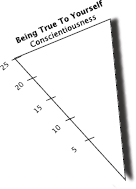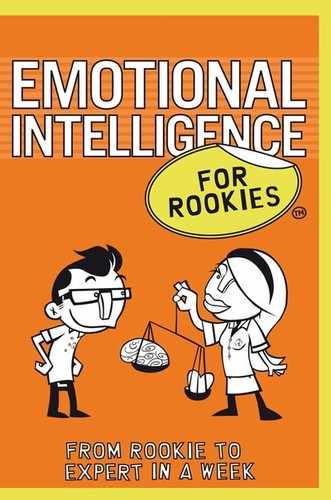CHAPTER 9
Being true to yourself
What is conscientiousness?
This chapter helps you to strengthen your conscientiousness by:
• Doing what is right, and managing compromise when needed.
• Having the courage to say “No”.
• Clarifying the expectations you have of others and that they have of you.
• Behaving consistently.
• Communicating with congruency.
Higgs and Dulewicz give this definition of conscientiousness: “The capability to display clear commitment to a course of action in the face of challenge and to match ‘words and deeds’ in encouraging others to support the chosen direction. The personal commitment to pursuing an ethical solution to a difficult business issue or problem.”
Take a moment to reflect on this definition.
• What is it saying to you?
• Which are the key words or phrases that stand out?
• Why are they important to you?
It’s about being true to yourself
In essence, conscientiousness is about listening to your conscience and having the integrity to stay true to yourself.

It’s about being guided by your principles: personal standards, beliefs and values. These come from your inner self, and have been shaped and defined throughout your life, giving you a feeling of what’s right and wrong, what’s possible or impossible. These inner principles give you a sense of identity, provide a rationale and drive your actions.
Conscientiousness is about maintaining congruency between what you feel, what you say and what you do, and having the courage to follow things through in a way that you believe is appropriate.
 Rookie Buster
Rookie Buster
Conscientiousness is about maintaining congruency between what you feel, what you say and what you do.
Why is conscientiousness important?
Conscientiousness helps you to determine the right thing to do in any given set of circumstances. An “internal processing” person naturally checks themselves against their own judgements and standards before making a decision or taking action.
They ask themselves:
• Is this the right thing to do in this situation?
• Does it reflect me in the way I would want it to?
• Will this send the right message?
• Do I feel comfortable about doing this?
When your beliefs, values, words and actions are all aligned, you feel calm and at ease. There is congruency between your emotional state, your physiology and your inner conscience.
 Rookie Buster
Rookie Buster
When your beliefs, values, words and actions are all aligned, you feel calm and at ease.
When things are not aligned, you feel a sense of unease, agitation and discomfort. There is incongruency within. Then you need courage to explore these feelings, to face up to the reality of what is causing them, and to seek to address them. It may require a tough conversation and it may make you unpopular with others, but ultimately you will feel better and be able to continue to perform effectively.
Tip: If it is not natural for you to process information internally, seek feedback from others. Ask them how your proposed decision or action could be interpreted. Then decide if that is what you really want to project to others.
Conscientiousness is important in creating:
• A professional personal culture.
• A credible and trustworthy organizational culture.
• An environment where quality is of the highest order.
• A society where people care about others and the environment.
Exercise – Dealing with incongruent feelings
Your colleague is too busy to attend a meeting and has asked you to stand in for him. He’s asked you to tell the client that he’s off sick. You’re not happy about this.
How would you feel?
What would you do?
What would you or your colleague need to do to make you feel happy with this situation?
Illustrating high conscientiousness
People with high levels of conscientiousness:
• Set and adhere to high personal standards.
• Live by their values and do not compromise.
• Show great determination and “go the extra mile”.
• Honour promises and deliver on the commitments they make.
• Are committed to achieving their desired outcome.
• Are disciplined in their approach.
• Take responsibility for their own actions and decisions.
• Continually improve – aim always to be and to do the best they can.
• Behave ethically – uphold professional rules and conform to norms.
• Are regarded as genuine and authentic.
• Are open and transparent in dealing with others.
• Treat others fairly.
• Show sincerity, integrity and emotional honesty.
• Are loyal and trustworthy.
• Show consistency in their approach, behaviour and words.
Exercise – How conscientious am I?
Think about your current projects or “to do” list and, taking each task in turn, consider how you feel in relation to the actions you have taken and need to take.
Identify those things that make you feel uncomfortable.
Ask yourself:
Why do I feel uncomfortable?
What do I need to do to make me feel at ease?
What are the consequences if I don’t address those things?
Now reflect on your notes and ask yourself:
• What message does my action or inaction send to others?
• Is this how I want them to view me?
• On a scale of 1–10, how conscientious do I believe I am?
![]()
Personal reflection: Lessons I have learned about myself
Finally take a few minutes to draw out three key lessons you have learned about yourself, and record them here.
1._________________________________________________________________________________________
2._________________________________________________________________________________________
3._________________________________________________________________________________________
What can affect your conscientiousness?
Your conscientiousness can be affected if:
• Your values or ethics are misaligned.
• You find it difficult to say “No”.
• Expectations are not openly shared and discussed.
Aligning values and ethics
From time to time you will be faced with a dilemma that challenges your values and ethics. Perhaps it’s a project with a new client in a business sector that you can’t condone, such as gambling or smoking; perhaps it’s an organization with a corporate responsibility policy that doesn’t reflect your social or environmental views; or perhaps you need to work with a colleague whose values or standards are completely at odds with your own.
Whatever the situation, this dilemma will undermine your conscientiousness and cause you unnecessary angst and anxiety unless you can resolve it in some way.
Be brave and consider the situation carefully and its implications for:

• Your attitude and mood, and its impact on your self-belief and motivation.
• The way you behave, and the effect that has on others.
• Your health and well-being.
• Your commitment to the project.
• The quality of the work you deliver.
• Your promotion prospects.
Facing up to such dilemmas is not easy, but an emotionally intelligent person knows that they need to find a solution that is acceptable to them and others involved. Being open and honest at an early stage may allow an early exit from the project; alternatively, find an acceptable compromise.
Tip: Compromising your principles is not sustainable over prolonged periods. If you are in an environment where your conscientiousness is continually challenged; when you often have an uncomfortable or twisted feeling in your stomach, or regularly suffer from headaches, consider whether your personal values are really aligned to the organization’s values. If they aren’t, move on before your health suffers irrevocably and you become truly unhappy.
It is tough accepting a compromise when you hold strong beliefs, and it is important to develop a deep sense of self-awareness and strong emotional resilience. Develop strategies to change your state and overcome the inevitable feelings of discomfort, guilt and upset (see Chapter 3). Learn the breathing technique in Chapter 4 to manage your physiology and maintain coherence within.
Say “No” when you need to
Some people just can’t say “No”! Sometimes this is personality driven – maybe you’re a person who likes to please others or to help out, and who would not dream of saying “No” to a needy colleague or team member. But sometimes it’s a case of learning how to say “No” or how to be more assertive when you really need to be.
Taking on more than you can reasonably deliver has negative consequences if you can’t fulfil your commitments. If you deliver late or not at all, if you forget to follow through or simply run out of time, your credibility is undermined.
Excuses and further promises aren’t enough. Even if others appreciate your good intentions, they perceive you as disorganized or unreliable. This reflects poor conscientiousness.
Tip: Be realistic and honest before committing yourself to take on a task. Think about the practicalities of what you need to do and the timeframe. Then stop and consider how you really feel – listen to your intuitive voice. What do you hear that voice saying? Also consider your physiology; if you feel your body temperature rising or feel sick, you are anxious; if you feel a lightness in your body, you are receptive.
 Rookie Buster
Rookie Buster
Taking on more than you can reasonably deliver has negative consequences if you can’t fulfil your commitments.
Share and discuss expectations
It is easy to assume that everyone has the same standards of personal conduct and that their expectations regarding the quality of work and client care are equal, but in reality this is not always the case.
Perhaps you feel uncomfortable and frustrated by the work ethic or attitude of others, or experience an uneasy feeling when you don’t consider yourself to be the best person for a particular job. Maybe you question whether you are good enough or even worry that you always let others down.
Whenever anything jars with your conscientiousness, take note. Have the courage to face the issue. Openly discuss your expectations of others and find out their expectations of you. By clarifying what’s expected, you eliminate uncertainty and reduce the likelihood of disappointment. If you find your own expectations or self-imposed targets are too high, reduce the pressure you place on yourself.
 Rookie Buster
Rookie Buster
Openly discuss your expectations of others and find out their expectations of you.
Tip: Manage expectations – ask others what they expect of you and set out your expectations of them. Openly discuss and clarify both sets of expectations.
Tip: Identify a set of operating standards or values for yourself and others – once expectations are shared, identify and agree standards, such as what’s acceptable in terms of language, behaviour and quality of work.
How does your conscientiousness affect others?
Conscientiousness is about consistency and congruency in the language you use and the behaviour you model.
Being consistent, regardless of how you feel or the pressure you are under, gives others a sense of reassurance and builds their belief in you. They instinctively know how you are likely to react to a certain issue or handle their particular concern.
Showing consistency also increases respect and engenders trust, as people know exactly where they stand. They are also more likely to share their mistakes, rather than cover them up and hope you won’t find out!
 Rookie Buster
Rookie Buster
Being consistent, regardless of how you feel or the pressure you are under, gives others a sense of reassurance and builds their belief in you.
Congruency is important in delivering your message. Show your belief in a cause through your passion and drive. Engage others by letting them see, hear and feel this, so that they know you really care.
When your words, tone of voice and body language do not give the same message, others know. When it is apparent that you don’t really believe in what you are saying, it is hard to get the support and commitment you need. Conscientiousness drives motivation, guides actions and enables you to uphold your values. By taking actions that support your words, you appear authentic and sincere. By modelling behaviour that you want others to adopt, and by introducing values you want others to operate by, you create a culture of conscientiousness that drives performance, engenders mutual respect and maintains business ethics.
Being comfortable with yourself enables transparency – an authentic openness to others about one’s feelings, beliefs and actions – which in turn builds trust in others.
Being true to yourself: Bringing conscientiousness to life
Your starting point

1. Transfer into this box your conscientiousness score from the EI self-perception questionnaire in Chapter 2.

2. Now that you know more about conscientiousness, re-evaluate this score and plot on the Being True to Yourself blade above. This score is an indicator of your level of conscientiousness, and is based on your self-perception.
3. Reflect on your entries in your emotions diary, and if you recognize there is scope for strengthening your conscientiousness, take some time here to jot down your ideas. You may like to think about this in terms of what you could start, stop and continue.
• Start – for example, having the courage to say “No” when I feel uncomfortable with what I am being asked to do.
• Stop – for example, stop accepting second best, and instead be clear about my expectations of others.
• Continue – for example, continue role modelling the behaviours I would like others to adopt.
4. Use The Johari Window template in the Appendix and consider, in relation to conscientiousness, how you behave and how you feel. Jot down your behaviours (Box 1) and your feelings (Box 2).

5. Your conscientiousness will have an impact on others. To gain a true understanding of this, you need to ask others for their feedback. Identify four people who know you well in the workplace and use the five statements from the conscientiousness section of the EI questionnaire (page 38 in Chapter 2) as prompts for discussion with each of them. Their perceptions will provide valuable data – some may confirm your own perception, while some may differ.
6. Go back to The Johari Window template and in Box 1 capture the perceptions shared by you and others. Then complete Box 3 and record anything you had been previously unaware of. The real value of this exercise is discovering things you don’t already know about yourself.
7. Based on your findings, revisit and, if necessary, revise your start, stop and continue actions.
You can now bring your conscientiousness to life through the following personal development activities.
Personal development activities
1. Creating consistency
How you see yourself and how others see you varies enormously.
Your beliefs, values, standards and attitudes are determined by your inner self and are held within. Others cannot see these.
However, other people have a perception of who you are and what you believe in. They interpret what you say and do, and pick up on subtle nuances – your moods, attitude and the way you interact with others.
These messages create a picture of you. They set the tone for how others respond to you. Everyone sees you differently, depending on how you respond to them.
How others describe you may therefore differ from how you would describe yourself. Perhaps you believe you are loyal, reliable and fun. But would others say the same?
Take some time to complete this exercise. It requires your interaction with others who know you well. You may be in for some surprises. And it may explain why you don’t always have the response you expect, the support you require or the fun you would like.
Step 1
Think of three words that describe you well. (These are your “descriptors”.)
Step 2
Now ask at least five other people, independently and without being prompted, to think of three words of their own to describe you. These other people may be:
• A partner.
• Friends.
• Family members.
• Colleagues or peers.
• Others who report directly to you at work.
• Clients.

Ask each person to write down the three words. Ensure you can identify who says what – you’ll need to know this later.
Step 3
Review all the words used to describe you, and identify those words that are the same or similar, and which appear three or more times.
Take this as your common set of descriptors, and compare it with your own descriptors.
Reflect on the following questions:
• Do others see me as I see myself?
• What surprises me?
– What do others see that I don’t value in myself?
– What don’t others see in me that I value in myself?
• What descriptors are unique to certain relationships?
– What do I do that gives that person that impression?
– What do I need to do differently in that relationship?
– What could I do differently in other relationships?
Reflect on what you have learned about yourself, and consider any inconsistencies in your behaviour. Identify what you can do to change perceptions by strengthening your conscientiousness.
Remember, how others react to you is determined by the impression that you give them.
2. Defining your values
Your personal values are at the heart of your conscientiousness. They influence what you do and why you do it. It is the integrity to stay true to your values when faced with dilemmas that differentiates the emotionally intelligent person.
1. Reflect on your inner values and identify three that you believe to be your core values.
If you find it difficult to identify your values, try asking yourself the question “What really matters to me and makes me feel good?”
For example, maybe you enjoy working on new projects that stretch you and that are outside your comfort zone, both intellectually and emotionally – if so, you might identify “continual improvement” as one of your core values.
Alternatively, ask yourself, “What do I find annoying about how others behave, or the things they say?”
Perhaps you get frustrated when other people arrive late for meetings, are not prepared and don’t seem to care about how they present themselves. If so, you might identify “professionalism” as one of your core values.
2. Now define what you actually mean by this value. What would you be doing or seeing if you were displaying this value?
For example:
• Enjoyment – having fun; working in a sociable environment.
• Co-operation – being part of a team; working closely with others.
• Uniqueness – being different; standing out from the crowd.
Coach’s notes 
Have the courage to be true to yourself and to be a role model for others.
Be true to yourself
• Show passion for your beliefs, and stand by your principles.
• Recognize any feelings of unease or inner conflict, and address them.
• Ask others what they expect from you – then you know if you are meeting their expectations.
• Recognize what you can and cannot do. Be open with others about them.
• Always deliver on your promises; create the time you need to ensure that you can deliver.
• Demonstrate integrity and ensure that you do what you say you will do. Ask others for their perception.
• Be accountable. Set milestones and measures. Openly share what you are doing with others and review progress.
Be a role model
• Be consistent in your behaviour, and show congruency when delivering a message. Your words, tone of voice and body language must be aligned.
• Check what others have heard, when communicating; don’t assume everyone has got the right message.
• Be open and honest in terms of your expectations of others.
• Demonstrate your passion always to be and to do your best.
• Be fair; treat everyone the same.
• Appreciate cultural differences, and learn to accept them and to work with others.
• Recognize that the values and beliefs of others will differ from your own; therefore discuss and agree minimum operating standards.
• Demonstrate that you are prepared to do yourself what you ask of others.
Go for it! Live by your values and principles, and act with conviction and authenticity.

Notes |

